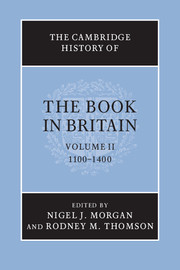Book contents
- Frontmatter
- Preface
- The roles of books
- Book production
- Readership, libraries, texts and contexts
- 9 Library catalogues and indexes
- 10 University and monastic texts
- 11 Law
- 12 Books for the liturgy and private prayer
- 13 Compilations for preaching and Lollard literature
- 14 Spiritual writings and religious instruction
- 15 Vernacular literature and its readership
- 16 History and history books
- 17 Archive books
- 18 Scientific and medical writings
- I The introduction of scientific texts into Britain, c. 1100–1250
- II University books and the sciences, c.1250–1400
- 19 Music
- 20 Illustration and ornament
- List of abbreviations
- Bibliography
- Photo credits
- General index
- Index of manuscripts
- Plates 1
- Plates 2
- References
I - The introduction of scientific texts into Britain, c. 1100–1250
from 18 - Scientific and medical writings
Published online by Cambridge University Press: 28 November 2008
- Frontmatter
- Preface
- The roles of books
- Book production
- Readership, libraries, texts and contexts
- 9 Library catalogues and indexes
- 10 University and monastic texts
- 11 Law
- 12 Books for the liturgy and private prayer
- 13 Compilations for preaching and Lollard literature
- 14 Spiritual writings and religious instruction
- 15 Vernacular literature and its readership
- 16 History and history books
- 17 Archive books
- 18 Scientific and medical writings
- I The introduction of scientific texts into Britain, c. 1100–1250
- II University books and the sciences, c.1250–1400
- 19 Music
- 20 Illustration and ornament
- List of abbreviations
- Bibliography
- Photo credits
- General index
- Index of manuscripts
- Plates 1
- Plates 2
- References
Summary
The Norman conquest of England occurred within the same generation as the reconquests of Muslim-held territory: namely those of Sicily (1060s), Toledo (1085), and parts of the Middle East (1098). One result of the English Norman Conquest was the refurbishment of the libraries of English monasteries, and it is not surprising that included among the new books imported and copied should be those containing texts made available by Christendom’s expansion at the expense of Islam. The earliest of such books, however, probably arrived not as a result of conquest. These were the corpus of Arabic medical texts that Constantine the African is said to have brought from Qayrawan (in present-day Tunisia) to Salerno and translated with colleagues in the Benedictine monastery of Montecassino in the last years of the eleventh century. Already in the early twelfth century copies of these medical texts had been brought to, or made in, English monasteries, among them Cambridge, Trinity College, ms. R. 14. 34, and London, Wellcome Historical Library, ms. 801A (both from Bury St Edmunds Abbey) and BL, Add. ms. 22719, which belonged to St Nicholas in Exeter (a dependency of Battle Abbey). A translation of Arabic astronomical tables from Spain was copied together with notes in Arabic and original texts by Walcher, abbot of Great Malvern (d. 1135), in the scriptorium of Worcester Cathedral Priory between c.1120 and 1140 (now Bodleian, Auct. ms. F. 1. 9). A medical text translated in Antioch in 1127 was already being copied in the scriptorium of Worcester Cathedral by the mid-twelfth century (Worcester, Cathedral Library, ms. f. 40).
- Type
- Chapter
- Information
- The Cambridge History of the Book in Britain , pp. 446 - 453Publisher: Cambridge University PressPrint publication year: 2008



